RETRACTED: The effect of negative pressure wound therapy on the outcome of diabetic foot ulcers: A meta-analysis
Abstract
Negative pressure injury is one of the auxiliary methods of treating diabetes foot ulcers. It has been shown to be superior to conventional techniques in randomized controlled trials (RCTs). Nevertheless, the results of observational research are still scarce. A systematic review of RCTs and observations was carried out to evaluate the effectiveness and security of negative pressure wound therapy (NPWT) treatment for diabetes foot ulcers. Three English e-databases have been found for NPWT research. The meta-analyses of the comparative studies provided point estimates of results. Intermediate results were given as median and binary values were given in the form of odds ratios (OR). Seventeen trials, 13 RCTs and four randomized, controlled trials were found in the survey. Of these, 831 were treated with NPWT, 834 were treated with standard therapy. A total of 14 studies have been conducted to investigate the influence of NPWT on the healing of diabetic foot ulcers(DFU). In the study, NPWT was shown to speed up the healing of the wound in DFU patients(OR, 2.57; 95% CI, 1.72, 3.85 p < 0.0001). A subgroup analysis showed that NPWT was associated with an acceleration of the wound healing rate in 10 RCT trials (OR, 2.48; 95% CI, 1.58, 3.89 p < 0.001). In the four nRCT trials, NPWT was also shown to speed up the healing of the wound(OR, 2.95; 95% CI, 1.03, 8.42 p = 0.04). In 11 studies, the influence of NPWT on amputations of diabetes mellitus (DM) foot ulcers was investigated. The results showed that NPWT was associated with a reduction in amputations (OR, 0.53; 95% CI, 0.37, 0.74 p = 0.0002).In a subgroup of RCT trials, nine RCT trials showed a reduction in amputations(OR, 0.61; 95% CI, 0.43, 0.87 p = 0.007). In both nRCT trials, NPWT also showed a reduction in amputations (OR, 0.03; 95% CI, 0.00, 0.24 p = 0.001). Generally speaking, NPWT can help to heal the wound and lower the risk of amputations in people with diabetes. The subgroup analysis showed similar results for the RCT and non-RCT trials. NPWT can be used to treat diabetes foot ulcers caused by diabetes.
1 INTRODUCTION
Over the last few years, with the rise in the incidence of diabetes, the complications associated with diabetes.1 Diabetic foot ulcers are an increasingly common complication of diabetes, with a high incidence and death rate worldwide.2 Diabetes resulting in peripheral neuropathy and vasculopathy, which causes dry and irritated toes and eventually results in sores that will not heal in time.3
Sadly, there has been little effect on the number of amputations related to diabetes in the last few decades.4 On the other hand, a few countries, including Belgium, have successfully achieved a reduction in the incidence of diabetes-related adverse events following systematic organizational reforms.5
There are several common treatment methods for DM, based on the kind of DM. These include surgical debridement of the wound and systematic use of broad spectrum antibiotics when infection occurs.6 In certain cases, however, such conventional approaches do not work and can lead to long recovery, ulcerations and amputations. In the last few years, a variety of therapies have been promoted including advanced wound dressings and other wound treatments.
Along with the development of new therapies, a number of novel therapy methods based on cell histologic and biochemical methods have been developed.7 Of all kinds of auxiliary and support methods, such as bioengineered skin transplantation and NPWT, seem especially promising for treating diabetic foot ulcers.8 NPWT is a novel and non-invasive adjunct therapy. NPWT is a machine that creates a vacuum in the area of the injury with the external environment, which contributes to the recovery of the wound by removal of liquid from the open wound, preparation of the wound bed for closing, reduction of swelling and promotion of granulating and perfusing.9, 10 Although NPWT is generally acknowledged to be efficacious, there are large differences in the reports from the clinical literature and insufficient quantification of the findings.
A number of clinical studies have shown that NPWT is a very efficient and secure way to improve the healing of the leg.11, 12 It is also worth noting that NPWT seems to be more costly for treating diabetes foot ulcers compared with conventional approaches. While some prior studies have concentrated on one or more NWPT factors in treating DM, e.g. in terms of effectiveness, safety and cost-effectiveness, it is not always possible to evaluate all these elements at the same time. Thus, there is a pressing need for a standardized meta-analysis that uses the evidence from current studies to evaluate the effectiveness and security of NPWT in treating DM and may offer a comprehensive assessment of the possible benefits of NPWT. The purpose of this meta-analysis is to evaluate the effectiveness and security of NPWT as an adjunct to DFU.
2 METHODS
2.1 Eligibility criteria
Observations are covered by this system if they are published in full text. Our definition of an observational trial is that it is reported using a methodology that is consistent with clinical practice. The trial was ruled out as it was not representative of normal clinical practice. The definition of an observational trial is that the investigators do not interfere with the patient's care, but merely watch the outcome of their choice of treatment. Ulcers not related to diabetes or restricted to a body area outside the leg were excluded. In order to take account of clinical diversity, there was no limit to NPWT and add-on treatment.
2.2 Search strategy
From its inception through Jan 2024, a literature search was performed to determine related research on adverse pressure injuries in treating diabetes with EMBASE, Pubmed and Cochrane Library databases. Furthermore, the references of the articles and processes were examined for other related references. Keywords such as “Negative Pressure Injury Treatment,” “Diabetes Foot” and “Diabetes Ulcer.” See Table 1 for a more detailed search policy.
| No. | Query |
|---|---|
| #1 | Negative pressure wound therapy[Title] OR Negative pressure therapy[Title] OR NPWT[Title] OR Vacuum assisted closure[Title] OR Vacuum sealing drainage[Title] OR VSD[Title] OR VAC[Title] OR Sealed surface wound suction[Title] |
| #2 | Diabetic foot[Title] |
| #3 | #1 AND #2 |
2.3 Inclusion and exclusion criteria
- All the participants were diabetic foot ulcers.
- Subjects were classified into two groups: intervention and control.
- Outcomes of the study were of interest.
- Injury of the leg that is not caused by diabetes.
- Studies with no result measurement or incomplete data.
2.4 Quality assessment
The results were evaluated separately by two investigators for each of the included trials, and the related data were retrieved. Disagreements were settled by discussion or the judgement of a third author. The Cochrane Collaboration instrument for evaluating the risk of bias was used to evaluate the quality of every contained RCT trial. This instrument covers six areas. Data from nonrandomized, controlled studies were evaluated using ROBINS-I.
2.5 Data collection
The database has been searched by two authors, and the index has been compiled by the two researchers. Then, the first screening is done by reading the headline and the abstract. Additional screening was performed by reading the whole text and the articles were screened according to the inclusion and exclusion criteria. In case of disagreement in the selection procedure, a third-party arbitrator is recommended. Data including the author, the release date, the amount of the intervention, the age and the result index were gathered at the time of the full text. Data were converted for further synthesis and analysis.
2.6 Data analysis
All data were evaluated with Revman 5.3 software. First, we conducted a chi-square analysis to see whether there were differences in the results. Values of p > 0.1 and I2 < 50% showed that there were no statistically significant differences among trials. Here, we analyse the data with a fixed-effect model. But when p < 0.1, I2 > 50%, and no clinically heterogeneous data were found, we selected a random effect model. The mean difference (MD) and 95% CI were computed for the continuum and the ratio ratio (OR), respectively, and 95% CI for the binary variables. A two-sided p-value below 0.05 was taken as an indication of the statistical significance (Figure 1).
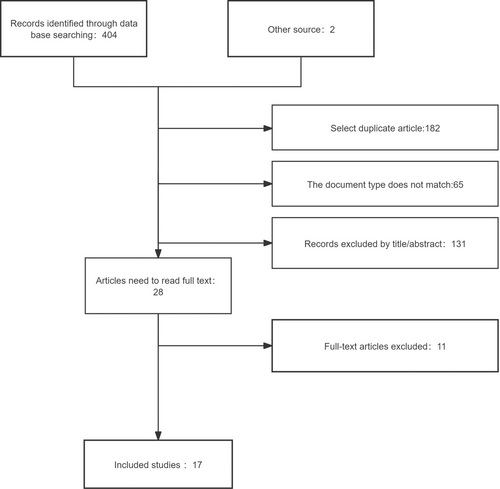
3 RESULTS
3.1 Study characteristics
In this paper, 406 related researches were collected from three English databases, and 17 related research were collected under the current exclusion criteria. Of these, 831 cases were treated by NPWT, 834 were treated with standard therapy. The features of the inclusion of DM foot ulcers are presented in Table 2. Quality assessments for contained RCT references are presented in Figures 2 and 3. Quality assessment results for the contained nRCT references are presented in Figures 4 and 5.
| Study | Year | Style | Country | NPWT | Age | Standard | Age |
|---|---|---|---|---|---|---|---|
| Anjum13 | 2022 | RCT | Pakistan | 20 | 42.95 ± 9.29 | 20 | 46.30 ± 9.33 |
| Armstrong14 | 2005 | RCT | USA | 77 | 57.2 ± 13.4 | 85 | 60.1 ± 12.2 |
| Blume15 | 2008 | RCT | USA | 169 | 58 ± 12 | 169 | 59 ± 12 |
| Borys16 | 2018 | nRCT | Poland | 53 | 65.4 ± 8.6 | 22 | 64.2 ± 6.8 |
| Chiang17 | 2017 | RCT | Australia | 12 | 61.0 ± 12.9 | 10 | 62.0 ± 13.9 |
| Ikura18 | 2014 | nRCT | Japan | 32 | 60.0 ± 15.4 | 48 | 63.5 ± 13.8 |
| James19 | 2019 | RCT | India | 27 | 55.85 (35–95) | 27 | 52.89 (28–70) |
| Lone20 | 2014 | RCT | India | 28 | 53.79 ± 5.45 | 28 | 54.57 ± 4.78 |
| Malekpour21 | 2021 | RCT | Iran | 30 | 70.31 ± 5.92 | 30 | 71.80 ± 6.32 |
| Maranna22 | 2021 | RCT | India | 22 | 50.23 ± 10.52 | 23 | 49.00 ± 10.14 |
| Nain23 C | 2011 | RCT | India | 15 | 61.33 ± 7.63 | 15 | 55.40 ± 11.54 |
| Prasad24 | 2024 | RCT | UK | 50 | 62.5 ± 8.3 | 50 | 63.8 ± 7.9 |
| Ravari25 | 2013 | RCT | Iran | 10 | — | 13 | — |
| Seidel26 | 2020 | RCT | Germany | 171 | 67.6 ± 12.3 | 174 | 68.1 ± 11.5 |
| Shams27 | 2023 | RCT | Pakistan | 40 | 58.13 ± 8.44 | 40 | 56.89 ± 7.23 |
| Ulusal28 | 2011 | nRCT | Turkey | 15 | — | 20 | — |
| Vaidhya29 | 2015 | nRCT | India | 60 | — | 60 | — |
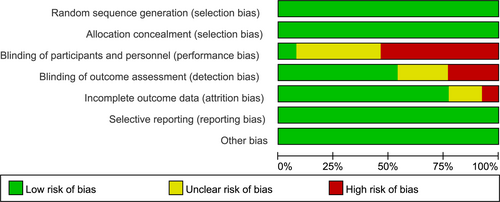
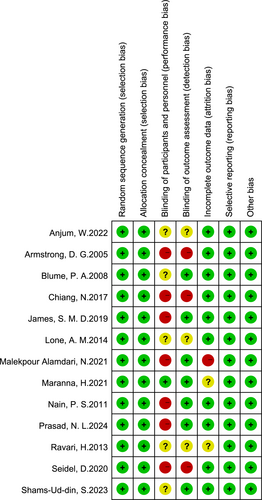

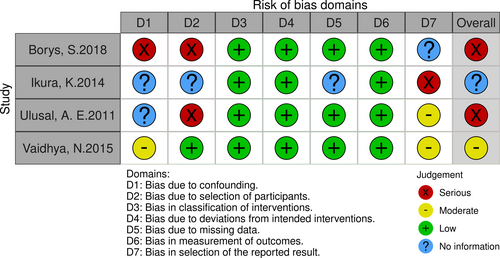
3.2 Wound healing
A total of 14 studies have been conducted to investigate the influence of NPWT and non-NPWT in patients with diabetes mellitus. In these trials, NPWT was shown to speed up wound healing (OR, 2.57; 95% CI, 1.72, 3.85 p < 0.0001), Figure 6. Since there were no notable differences in the two trials (I2 = 50%), we conducted a subset of the results by reference type. In 10 RCT trials, NPWT has been shown to speed up wound healing in DM foot ulcers (OR, 2.48; 95% CI, 1.58, 3.89 p < 0.001), Figure 7. NPWT has also been shown to speed up the healing of the wound in patients with DM in the 4 nRCT trials (OR, 2.95; 95% CI, 1.03, 8.42 p = 0.04), Figure 7.
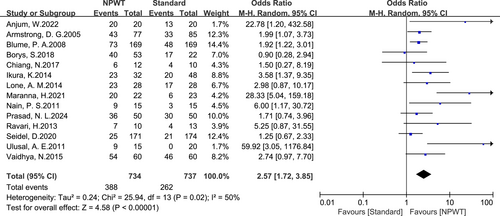

3.3 Amputation
The impact of NPWT and non-NPWT on amputations in diabetic foot ulcers was investigated in 11 studies. The results showed that NPWT was associated with a reduction in amputations (OR, 0.53; 95% CI, 0.37, 0.74 p = 0.0002), Figure 8. The published errors of the 11 trials are presented in Figure 9. Since RCT and nRCT trials were also involved, we analysed the outcomes by group by literature category. In nine RCT trials, NPWT showed a reduction in amputations (OR, 0.61; 95% CI, 0.43, 0.87 p = 0.007), Figure 10. In both nRCT trials, NPWT also showed a reduction in amputations (OR, 0.03; 95% CI, 0.00, 0.24 p = 0.001), Figure 10.

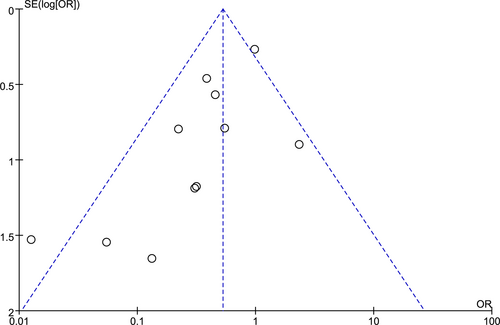
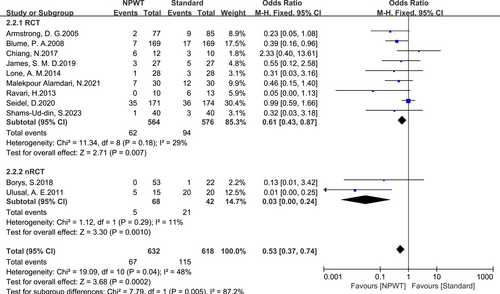
4 DISCUSSION
The abnormal cellular proliferation, vascular dysfunction, micro-environment, inflammation and so on are the major causes of DF incorrection.30 Vacuum Injury Treatment is a technique that utilizes various types of internal and external forces to remove dead tissue and excretions from the wound, thereby decreasing the rate of infection and maintaining moisture in the wound.31 Nevertheless, the results of the study were inconsistent, the data were mixed and the combined effect was not strong. The meta-analyses of prior researchers contained 11 randomized controlled studies, however most of these studies were pre-2010, and the majority did not describe randomization techniques or treatments.32 There are 17 related trials in this trial, with 13 RCTs and four nRCTs. The number of trials before 2010 was 2 for all the trials. This is a good way to make up for the absence of prior research.
Conventional wound management employs a variety of different types of bandages to facilitate the healing of the wound, but the bandages often stick to the scar.33 The NPWT technique has been shown to be effective in improving the micro-environmental condition of the injury, altering the haemodynamics of micro-vasculature and controlling the infection of the wound.34 The most frequent side effects during therapy are swelling of the wound, bleeding, pain and infection. Adequate adjustment of negative pressure has been demonstrated in order to prevent a propensity for bleeding and complete closure of the cut.35 To prevent amputations in the past, appropriate assessment of a prior history of DM, optimization of serum sugar levels to facilitate wound healing, and the provision of multidisciplinary treatment can be helpful in order to prevent amputations.36
In the current analysis of the findings, there are more than 10 test participants. We also conducted a subset of the findings. Finally, the final subgroup analysis was in agreement with the general findings. There are, however, certain limitations of this research.
Significant data from the data from the included trials are not entirely available. Currently, there is no stratification or randomization of the severity of DFU; thus, there is an imbalance between the two groups. Clinical diversity was also observed as a result of a small sample size, inadequate presentation of methodology details and inadequate follow-up time. Our reports might have been skewed by nonrandomized factors that influenced the assignment of a particular therapy. From the information we have gathered, it is clear that those with more serious injuries, especially those with bigger sores, are more likely to be classified as NPWT. Poor regression in DM with both conventional NPWT treatment and other trial methods might be associated with a preference for those with especially clinical problems. Furthermore, there were only a few trials in the comparator group, with the majority being performed on NPWT-treated patients. It is also important to point out that the lack of comparison data in meta-analyses does not allow for a robust evaluation of published bias. Lastly, it is possible that the documentation is not complete as we have only looked at the published papers. Thus, we need to be cautious in our meta-analyses.
5 CONCLUSION
Applying NPWT to patients with DFU will improve the healing of the wound and lower the risk of amputations. Similar results were observed in the RCT and non-RCT trials in the subgroup analysis. NPWT can be used to treat diabetes foot ulcers caused by diabetes.
ACKNOWLEDGEMENTS
We thank Prof. Fei Liu for his review of this study and suggestions for revisions.
CONFLICT OF INTEREST STATEMENT
The authors declare no conflict of interest.
Open Research
DATA AVAILABILITY STATEMENT
Data available on request from the authors.




